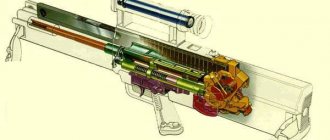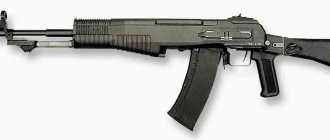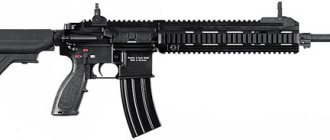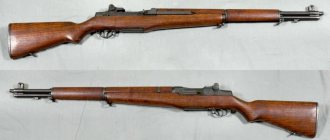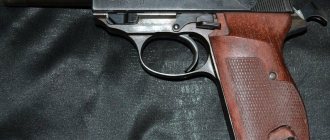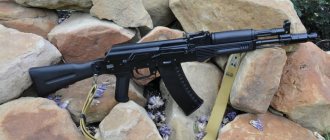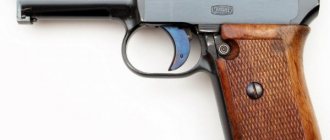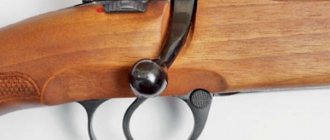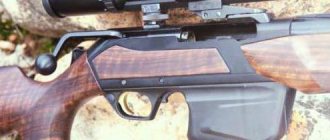Exactly. Qualitatively. Reliable. Inexpensive. Usually, when choosing a budget weapon, you have to be content with one, or maximum, two items from this list. Miracles don’t happen, and the high cost of creating a truly high-quality rifle also determines its high price in hunting stores. In any case, this is the widespread opinion on this issue. But how true is it? Let's find out.
The author of these lines has in his arsenal several “boltovikov” (rifles with a longitudinally sliding rotary bolt), and all of them are American manufacturers. There are a number of reasons for this, but the main thing is that the most shooting nation in the world is excellent at advertising and PR. Therefore, very often a strong impression is created that it is American gunsmiths who are ahead of the rest when it comes to any weapon. Including purely hunting ones.
Strong doubts that this is the case arose in me after my first acquaintance with the Blaser R8 carbines, which represent the pinnacle of engineering in the field of long-barreled rifled weapons with manual reloading. And these considerations were significantly strengthened after I had the opportunity to closely study the brainchild of German gunsmiths in the field of the budget segment of the market - the Mauser M18. This carbine turned out to be extremely attractive due to the combination of its characteristics, cost and practical test results.
However, there are other manufacturers in Germany whose history is no less legendary and also goes back centuries. And today we are getting acquainted with the affordable carbines of the Jaeger 10 family from one of the oldest, most venerable and simply the most famous German weapons manufacturers - the company CG Haenel GmbH, or simply Haenel.
A little history
Almost in the very center of Germany, on the wooded lands of Thuringia, from time immemorial there has been the glorious city of Suhl. It is famous not only for its antiquities and sights; Suhl is primarily known as a city of German gunsmiths. Here, for example, the JP Sauer & Sohn factory produced small arms for almost 200 years, raising entire dynasties of professional engineers and gunsmiths. And in 1854, Karl Gottlieb Haenel, a Prussian inspector of arms factories, organized his own production here, focused primarily on the military market.
The Haenel factory is known for its close cooperation with the legendary gunsmith Hugo Schmeisser: during the Second World War, it produced the legendary Sturmgewehr StG 44, as well as, of course, machine guns and other small arms for the Wehrmacht. After the surrender and division of Germany, Haenel was re-equipped and for some time produced hunting and sporting firearms with the Made in GDR mark under the Haenel Suhl brand. In 2008, the production of various models of weapons was re-established - both for civilian and for police and military use under the original brand.
Today, the main weapons production in Suhl is a factory that produces products of the Merkel and Haenel brands. The production belongs to the Merkel group of companies, but under the Haenel brand they produce original rifled weapon systems with manual and semi-automatic reloading. And their model range is expanding and growing from year to year.
Technology and design
You can be sure that the arms production, whose history goes back several hundred years, has enormous experience and an extensive supply of know-how, which allow it to offer weapons that can successfully compete in this oversaturated market - at least in Europe and the USA .
First of all, Haenel is famous for its barrels. Like many other German manufacturers, they are produced using the cold forging method. This method demonstrated its validity and very high efficiency even in wartime, but the Germans still consider it the best way to quickly and efficiently obtain a finished rifled barrel. The barrels come out of the forging machine in a couple of minutes and are accurate, very strong and reliable. They have faithfully served hunters in carbines and rifles for many years, without suffering too much from insufficient care or difficult weather conditions.
Haenel Jaeger 10 is a lightweight and comfortable bolt action carbine, perfect for most Ukrainian hunting
Within the Jaeger 10 family, several types of barrels are offered - regular ones with a standard contour (with a transverse diameter of 17 mm at the muzzle) and target ones with a semi-weight contour (respectively, 19 mm). Different calibers also require different barrel lengths: 560 mm for standard calibers, 610 mm for magnums. There are also variations with a short barrel of 510 mm and even 450 mm, the latter made without sights, equipped with a muzzle thread and intended for use purely with a sound moderator.
The Jaeger 10 front sight can be easily moved if necessary, revealing the M15x1 muzzle thread
All versions of Jaeger 10 for Ukraine are supplied with M15 standard muzzle threads. At the same time, it would seem that the high pedestal of the front sight installed on the Standard versions would interfere with the installation of muzzle devices, but everything is provided for: by unscrewing the only screw with a hex key, the front sight can be moved a few millimeters further from the muzzle. This allows you to easily install sound moderators produced by, say, Ase Utra, or use DTK. As for devices of a semi-integrated design, to install them the front sight will simply have to be removed. It is hardly worth clarifying that it would be most prudent to carry out these manipulations not in the field, but in a weapons workshop.
The trigger mechanism of the carbine is equipped with a trigger that reduces the trigger force to alarmingly light values
The mechanical sights themselves evoke a feeling of deep satisfaction with German weapons traditions. Everything here is as it should be on a modern carbine: bright light-accumulating threads, reliable adjustment mechanisms... In a word, it’s just the thing for a “corral”! And most importantly, from the factory, the sights are installed and adjusted in such a way that the carbine, right out of the box, allows you to effortlessly hit steel reactive targets at distances of 50, 75 and 100 m! But we are already getting a little ahead of ourselves.
The Jaeger 10's six-lug bolt is a classic European design; detachable magazine for 3-4 rounds is securely fixed in the stock
The Jaeger 10 bolt group is traditional for German manufacturers, but has its own characteristics. The longitudinally sliding rotary bolt has a collapsible design with a combat cylinder with six lugs. Thanks to this, the opening and closing angle of the bolt is no more than 60°, and the handle, set at an ergonomic angle slightly back, allows you to reload the carbine very quickly, without any interference from the installed optical sight and practically without leaving the weapon from the target.
The fuse has an additional bolt release lever for safe unloading. The protruding shank of the firing pin signals arming
The action of the shutter is light and pleasant, but you need to take into account that its body has a full diameter - and when moving, the shutter slides “with its whole body” along the steel receiver. Accordingly, their contact area is quite large. To make the reloading process as easy as possible, it is recommended to periodically treat the bolt body with lubricant and, of course, keep it clean.
The steel receiver is one-piece, with a closed upper part. It has four holes for mounting an optics base that is compatible with the Remington 700 standard. Installation is generally not difficult, but since this is a very important task, it is again worth entrusting this work to an experienced gunsmith.
installation of the Zeiss Conquest V4 3-12×56 universal sight requires preliminary installation of a Picatinny base (Remington 700 standard)
The carbine safety lock has two fixed positions. When the safety is installed, the bolt is securely locked so that the owner does not worry about it when transporting the weapon. If the carbine needs to be unloaded without removing the safety, then it is possible to push down the lock lever, which opens when the safety is engaged, and then perform all the necessary manipulations with the bolt. Quite simple and convenient. A cocked bolt signals its condition by a protruding hammer shank, which, if necessary, can be easily determined both visually and by touch.
The carbine is fed from a detachable magazine with a capacity of three rounds. The magazine has a steel body and a reliable double-row design, making it easy to load. The magazine is inserted in a straight motion, and is fixed in the stock flush with the fore-end. To remove the magazine, you need to push forward the latch lever located in front of the trigger guard with the index finger of the shooting hand.
The installed sight does not interfere with quickly reloading the carbine due to the small angle of raising the handle
Many hunters fear that detachable magazines can easily get lost while hunting during transitions. However, it seems to me that in this case there is no need to worry: the magazine is held securely, and the latch lever is small, and it requires a noticeable force to operate it.
Jaeger 10 stocks can be made of wood or plastic. For review, I was given a carbine in a plastic stock with a Soft Touch coating - very pleasant and soft to the touch with your hands. In general, I’m not a big fan of plastic stocks - but for this option, I’ll probably have to make an exception!
By the way, due to this coating and the well-thought-out shapes of the fore-end and handle, the lightweight carbine is held very tenaciously when fired, even if the shooter’s hands are cold, wet or sweaty. The soft butt plate perfectly compensates for the sharp recoil of large calibers.
The Jaeger 10 trigger is the highlight of the rifle. For example, it is very rare to find a really good trigger on American-made budget weapons. The Germans are fundamentally different in their approach to this issue: almost all German hunting weapons are equipped with excellent triggers, and some models are simply outstanding!
The mechanical sight of the Jaeger 10 is so good that the need for optics arises only at distances greater than 50-70 meters
In the Jaeger 10, Haenel installed a trigger with a trigger mechanism. This means that the trigger can operate in two modes: the usual single-stage, when the trigger force is about 800 g, and with pre-cocking - for this you need to move the trigger forward about 1 cm.
Even in normal mode, the descent is very comfortable and convenient: dry, clear, without stretching or play. With a sneller, he’s simply intimidating at first! A minimal trigger pull is sufficient to fire a shot; just touch your finger and a shot sounds!
They say about such descents that they are “afraid to breathe”; and there is some truth in this - the minimum force of the sneller is unsafe when handling a loaded carbine. Therefore, if your target has escaped and the need for a shot has disappeared, it is recommended to quickly remove the trigger from pre-cocking by raising and lowering the bolt handle. And in general, whether it is worth using a sneller for hunting is a big question. It seems to me that it will be more appropriate in sports competitions, and when shooting from stable, comfortable positions.
Haenel Jager 10 rifle
The Haenel company from Suhl, which has returned from obscurity, releases one new product after another. After a line of models with breaking barrels, we finally began to manufacture a repeating carbine with a bolt action. The Haenel Jager 10 presented at the IWA exhibition immediately aroused considerable interest in the professional circle of hunters. What attracts attention is not so much the successful design and finishing, but the tempting price below 100 euros.
The editors of DWJ were able to take a closer look at the new Zulian carbine. There are, of course, plenty of affordable carbines, but they usually come from the USA or the Far East. Haenel is produced in Suhl and is designed specifically for the tastes of German hunters. To date, Jager 10 is available in only one version. There are only two different barrel lengths depending on the caliber used: 56.5 cm for the standard and 61.5 cm for the magnum. The choice of ammunition here is also great: 6.5x55, .270 Win., 7x64, .3006, .308 Win., 8x57IS, 9.3x62, 7 mm Rem. Mag. and .300 Win. Mag. In all these calibers, the receiver and bolt stroke are the same length. The price of the product starts from 949 euros, and believe me, it is worth the money invested in it.
Slim and graceful
The Jager 10 has a slim silhouette with a pleasingly streamlined shape. The carbine looks an order of magnitude higher than the crude stamped cheap guns, the finishing of which is mainly done on CNC machines. The receiver is made elegantly and smoothly transitions into the barrel, which, after the massive part immediately behind the receiver, becomes thinner towards the muzzle. The butt has a straight comb and an elongated German cheekpiece. The pistol grip has some sealing on the right side. This stock shape will be very convenient for right-handed people.
In this model, they did not try to simultaneously satisfy the needs of both right-handers and left-handers, as is often the case in models of repeating rifles produced in the USA. What catches your eye is the rather long and thin bolt handle, which is wound slightly back. It may seem that the part is very fragile and is about to fall off, but this is not the case. The rubber butt pad not only looks incredibly soft, it actually feels very soft to the touch. The magazine, or rather its base, is the same in width as the stock. For the convenience of placing the magazine in the stock there is a special cutout.
Because the inserted magazine literally “cuts” flush into the stock, the weapon visually appears even thinner - a good optical trick. All metal parts, except the receiver, are coated black. The matte surface, as it turns out, is somewhat susceptible to scratches.
Bolt with 6 stops
The bolt closes in the barrel with 6 stops located in two rows on the combat face. Behind the three large stops are three smaller ones. The extractor and ejector are located on the shutter mirror. The upper receiver is a separate piece attached to the lower system, which includes the magazine well and trigger guard, with screws. The shutter release, an easy-to-use button, is located on the left side of the receiver. In the cocked state, the firing pin bushing is pulled back from the bolt shank, which is well protected from dust and contamination. Thus, even by touch in the dark, the shooter immediately feels whether the weapon is cocked.
The bolt handle is made in a very thin form, and at the base its diameter is 7.5 mm. It is completed by a drop-shaped ball, its diameter is 18 mm. The shutter handle is moved back slightly so that its position is flush with the trigger, this is convenient and speeds up manipulation of the shutter during reloading. The shutter opening angle is 60 degrees, and this makes the correct installation of any optics as easy as possible. Reloading of the Jager 10 is smooth and fast, and the bolt moves easily in the receiver.
The receiver jumpers have special holes for installing an optical sight. The test weapon was equipped with a rail 180 mm long and 12 mm wide. Trigger, safety and magazine Haenel has a trigger function, but can also be used as a regular one. The release is dry, without noticeable resistance, the force is 1600 g. For approach hunting, it would be good to reduce the force by 300-400 g, but this can be adjusted independently. The trigger is automatically turned off when the shutter is opened, but not when the safety is turned on, which would be very useful.
The trigger is smooth and located at the rear wall of the trigger guard. This leaves enough room to pull the trigger even when wearing gloves. The trigger guard and magazine holder are made of synthetic material. The magazine consists of a steel body mounted in a polymer base. The magazine feeder is also made of synthetic material. The magazine capacity is 3 rounds, there is a stop for the cartridge case hanger. The magazine release is integrated into the front of the trigger guard. To remove the magazine, you need to pull it forward. A similar type of lock is also used in the Heckler&Koch SLB 2000+ self-loading carbine. If there are still cartridges left in the magazine, then when the latch is released, it falls out of the shaft. At the base of the magazine body there are two plastic petals that serve for easy grip with your fingers, so that the empty magazine can be easily removed from the shaft. This ensures quick magazine changes. The equipped magazine is simply inserted into the narrow opening of the shaft, where it is easily secured, as evidenced by a click.
Sight on a thin barrel
The length of the free-oscillating hunting barrel is 56.5 cm, the diameter at the muzzle is 16 mm. It has a crown to protect it from mechanical damage. The barrel blank is made in Suhl, the barrel itself is made by cold forging. The finish of the inside of the barrel of the test weapon is very high, and therefore the barrel is easy to clean.
For shooting without optics, Haenel opted for open sights for offhand shooting, giving them a slightly modified shape. The rear sight is made from a single piece of synthetic material, the V-shaped slot is 2.6 mm wide. For ease of aiming, the slot has a white border so that the eye immediately concentrates on it. The front sight with an insert of a red reflective element with a diameter of 2 mm is adjustable in height. The trapezoidal base of the front sight with an adjustment unit is made of synthetic materials. The rear sight slot is somewhat narrow and does not harmonize very well with the round front sight. A wider U-shaped slot would have been much more appropriate here. The safety is located to the right of the trigger, acts on the sear, and is convenient and silent to use. In the retracted position it blocks the bolt. When the safety catch is pulled back, a second, smaller key becomes visible, which is hidden by the main flag when the weapon is removed from the safety catch. If you press this key, the shutter can be opened even with the carbine on.
Butt
The one-piece stock is made of walnut wood, the color on the test weapon was slightly reddish with a clearly visible pattern. The stock with a straight comb smoothly blends into the German cheekpiece. The right side of the pistol grip is made with some padding for easy grip. Both the fore-end and the handle are cut. The notch is medium in size, quite comfortable and does not cut into the hand too much. Of course, there are better options, but you can’t expect anything else for this price, because a high-quality checkering on the stock alone costs 250-300 euros today.
The forend is very thin and ends with some compaction. In front, at a distance of 30 cm from the muzzle, a swivel is attached. This is just enough to comfortably carry a weapon with a 56 cm long barrel over the shoulder on a belt. The 13mm thick rubber butt pad is moderately soft and absorbs recoil well. In its upper part there is a small smooth section, apparently, this was done in order to reduce friction when quickly throwing the carbine. The stock has two transverse screw fastenings, giving the weapon a fairly recognizable look. A synthetic stock is not yet available in the model range.
Optics and bar
The test gun was equipped with an 11mm rib with three notches at the front and two at the rear. This bracket is designed specifically for mounting optical mounts manufactured by Haenel. The bracket is somewhat reminiscent of the one that Heckler&Koch offered for semi-automatic SL8 carbines. At the top of the bracket with rings there is a fairly large lever that moves the clamping part that secures the bracket to the bar. In the closed position the lever is automatically locked. To unlock, you need to pull the lock directly behind the lever back. At the base of the bracket there is a protrusion for insertion into the grooves on the bar.
It will take some practice to get this tab into the grooves quickly, although this in turn increases the possibility of scratches. There is a choice between two positions for installing the bracket, there is a gap of 15 mm in front and back to select the correct eye relief. In winter, it is recommended to position the scope slightly closer than usual to compensate for the influence of outer clothing. In summer, the sight should be mounted further away. This option is not new at all; Sauer&Sohn already used it in the Sauer 303, and practice has confirmed the convenience of this innovation. During test firing, it turned out that the correctly fixed bar and bracket easily withstand recoil, and zeroing is not disrupted. Reinstalling the sight from the front to the rear position led to only a barely noticeable increase in the STP of 2-3 cm at 100 m, which could only be determined by a more thorough inspection of the targets. In general, this optics mounting system is excellent for driven hunting tasks. The test carbine was equipped with a Kaps 1.5-6×42 scope with an illuminated reticle. The TLB (Tages Licht Beleutung) function allows you to use the backlight in any external lighting conditions, both at dusk and on a bright sunny day. The sight has a compact design, its length is 300 mm. The optical characteristics are very good.
At the shooting range
The carbine in .308 Win caliber was, as usual, tested at the shooting range at a distance of 100 m. The cartridges were used with a bullet weight of 140 to 180 grains. In this popular caliber, the choice of possible options is quite wide. We can safely say that the .308 Win is represented in the assortment of almost every ammunition manufacturer. Our carbine preferred the 165 and 168 grain bullets. The weapon showed the best results using Winchester Supreme cartridges with a 168-grain Ballistic Silvertip bullet. With these cartridges we got a 21 mm group in a series of five shots. The next successful result with a dispersion diameter of 23 mm was obtained with Brenneke TOG cartridges with a 165-grain bullet. For such a thin trunk, very good performance. The balance of the weapon during shooting did not cause any comments. Despite the thin barrel, only after the 8th shot did the point of impact begin to shift somewhat.
Summary
The Jager 10 boldly competes with other repeating rifles. This model from the Suhl-based company is aimed at the lower price segment. The competitors here are not Sauer, Mauser, Blaser or Steyr, but rather Winchester, Remington, Browning or Tikka. This sleek rifle features a detachable magazine, an easy-to-use safety system, an excellent trigger with a trigger function, and the bolt can be opened even with the safety on. The accuracy is excellent and the weapon works reliably. At this price, you can hardly expect a carbine to have a manual cocking mechanism or the option of changing barrels. You'll have to put up with somewhat rustic open sights and a matte, scratch-prone surface.
First shooting
Contrary to fears, the lightweight Haenel Jaeger 10 in .30-06 caliber turned out to be very comfortable to shoot. The iron sights worked great out to 100m, and when shooting standing handheld at 10-round gongs I only had two misses - both at the longest range of 100m.
By the way, at this distance I just decided to test the trigger and regretted it - without the proper habit of an ultra-light descent, its operation was a surprise for me every time, and this is what led to misses. There are two options here: either learn to shoot with a sneller and get used to it, or return to the traditional trigger mode. Considering that there was not too much ammunition, and the winter day was quite short, I decided to postpone deep mastery of the sneller until more suitable times.
A similar carbine in .308 Win caliber does not differ from its brother in anything except the color of the stock and a slightly modified design of the magazine feeder. It is just as comfortable to shoot and turned out to shoot just as well out of the box. Satisfied with the results, I moved on to installing the optical sight.
Haenel-Jaeger 10 hunting rifle
Haenel-Jaeger 10 hunting carbine – for targeted shooting during driven or running hunting. The weapon is manufactured in the German city of Suhl; among European and American models, this is the best option in the mid-price range.
Model features
The Haenel-Jaeger 10 carbine is reloaded manually. The barrel is locked using a longitudinally rotating bolt with six lugs arranged in 2 rows. Spent cartridges are removed through an extractor. In the production of the barrel, cold forging was used, supplemented by internal processing. The diameter of the bolt handle is 7.5 mm, the muzzle is 16 mm. The handle is made quite durable, despite its openwork appearance. With a slight tilt back, the handle is located at the level of the trigger, which provides additional comfort and convenience when shooting. At the end of the handle there is an 18mm drop-shaped head. The shutter rotates 60 degrees.
The trigger mechanism of the model is of the striker type. The fire is carried out by performing single shots. The trigger equipped with a trigger has a direct action. In this case, the hook is slightly shifted towards the rear wall of the trigger guard. Opening the shutter disables the scheller. To descend, a force of 1.6 kg is required; if necessary, this figure varies at the request of the owner.
At the beginning of the trigger guard there is a magazine holder. The Haenel-Jaeger 10 model is equipped with a safety, its flag can be found on top of the trigger, on the right side. Moving the flag back locks the bolt, opening access to a button that allows you to retract the bolt even with the safety removed.
The model is equipped with a two-component receiver, which is an independent part on top and is fixed with screws. The butt of the carbine is a straight comb, gradually flowing into the Bavarian cheek. The butt plate is equipped with a pad made of soft material, having a thickness of 1.3 cm. The forend of the carbine, as well as the pistol grip, are equipped with a notch. The stock has a pair of screw mounts, giving the weapon a familiar silhouette. In addition, the manufacturer also produces rifle models with stocks made of synthetics.
Aim
The role of aiming markers is performed by the rear sight, as well as the adjustable front sight. A polymer material was chosen to make the rear sight with a V-shaped slot and white edging. The front sight is also made of polymer, it has a trapezoidal base and is equipped with an adjustment unit. The front sight has a red fiber optic pad, which provides better sighting in poor visibility. Optionally, the carbine can be equipped with a bracket used to fix the optical sight.
Cartridges are fed into the carbine through a removable box-type magazine, which can hold three standard or two Magnum cartridges.
You can read about the pros and cons of a detachable magazine in the article “Magazine in hunting weapons”.
The steel body of the magazine is fixed thanks to a synthetic base, and the material from which the feeder is made is a resistant polymer.
The Haenel-Jaeger 10 gauge 30-06 carbine is an excellent choice, available at an attractive price. With a light weight of no more than 3.2 kg and a barrel length of 560 mm, it will be an excellent option for true hunting connoisseurs.
Prices for carbines and their availability can be found in the supplier catalog.
Material prepared by Peter Senin
More on the topic:
Sabatti SAPHIRE hunting rifle
Strasser RS14 carbine
Rossi Rio Grande and Rossi 92 carbine: the end of the era of Brazilian carbines with Henry shackle
Similar
Lyrical digression
The question “Which caliber should I take for hunting - .308 Win or .30-06?” sounds in gun stores almost every day, and the answers to it vary depending on the experience (or imagination) of the sellers. For myself personally, I came to the following conclusion: if a few years ago I would have recommended the .30-06, now the popularity of the .308 Winchester is at its peak. It's probably worth preferring.
Ballistically, these calibers are quite comparable. More weapons are produced for .308 Win, including sporting varieties. The Springfield, perhaps, does not have any significant advantages - after all, in the 308, the shooter has access to Hornady Custom International cartridges with Interlock bullets weighing 220 grains (more than 14 g). Much harder! As for power, the difference between these calibers, in my opinion, is not fundamental.
If you suddenly want a truly “stunning” caliber in the literal sense of the word, choose the .300 Win Mag! There is more than enough power there, and if it confidently hits the target, it is unlikely to run anywhere. Another thing is that accurate shooting from a magnum is not a task for the weak in spirit and body. In this regard, both .308 Win and .30-06 will be many times more comfortable, and the cartridges for them are noticeably cheaper.
Accuracy shooting
Is an optical sight required on the Haenel Jaeger 10 carbine? Based on the results of the first test shooting, it can be stated that this is not always the case. That's the beauty of iron sights: you buy the weapon, unpack it, clean it, and you're ready to go hunting! At short and medium distances it will be quite effective. However, when distances increase, you certainly want more precise aiming.
The A-Tec Optima 45 sound moderator has a modular design and a quick installation system on the A-Lock barrel
In addition, there is a desire to try the carbine in accuracy shooting - it’s interesting how a budget German hunting weapon with a good pedigree shoots! As we remember, at one time the Mauser M18 captivated many gun reviewers with the promise of compact shooting in a series of five shots - no worse than 1 MOA. I would like to believe that “The Huntsman from Suhl” will also not be a failure in this regard, but to clarify this point, optics are needed. So it’s decided with the optical sight - let’s install it!
For a versatile optical sight with a reasonable price (roughly the price of a carbine), we install the Zeiss Conquest V4 scope with a magnification of 3-12x56 on the Jaeger 10. This is one of the most versatile models for hunting use, and it can be used both for individual hunting and for driven hunting, as well as for sports target shooting, and even for long-distance shooting - in my practice there was a case when it was necessary make a shot with such a sight at a distance of 520 m, and the target was successfully hit. In addition, due to the large diameter of the front lens, the scope “sees” very well in the twilight and in low light - and for hunters this is really important.
We mount the sight using Warne quick-release rings and use a Picatinny base from the same company. It is strongly recommended that you use a torque tool for all these manipulations and do not exceed a tightening torque of no more than 20-25 in-lb (2.2-2.8 Nm) for the base-to-receiver screws and half-ring screws.
The A-Lock Mini muzzle adapter allows you to instantly remove and install the Optima 45 sound moderator
It’s a little more interesting to install a sound moderator. Many hunters have already become convinced of the practicality, comfort and convenience of using these devices while hunting. After all, their main task is to reduce the deafening roar of a firearm shot to a level that is safe for the hearing of the shooter and others. At the same time, it is known from the experience of high-precision shooting that a high-quality moderator, firstly, noticeably softens the recoil of a weapon, and, secondly, improves the accuracy of its fire! Which means we need to bet.
First you need to remove the front sight; as already described, this is not difficult to do if you have a suitable key. Next, a small A-Lock Mini adapter is installed on the threads on the muzzle: when installing it, you must use a thread locker to securely fasten it to the barrel. Finally, now you can install the A-Tec Optima 45 moderator, and this is very simple: put on the device, turn it 45° clockwise - that’s it, the moderator is installed. Need to remove it? Not a problem at all: turn it counterclockwise, take it off and put it in a case, pocket or bag. Just a matter of seconds!
Without the middle module, the overall length of the Optima 45 moderator is noticeably reduced
Optima 45 quick-release moderators have another interesting feature. They are modular and allow you to either increase or decrease the number of chambers responsible for reducing the temperature and pressure of the powder gases (and, accordingly, reducing the volume of the shot). For example, the base model can be disassembled into three modules and the middle one removed to reduce the size of the weapon. Of course, the volume of the shot will increase compared to a full-size device, but in this case we are more interested in other aspects.
The short winter day was drawing to a close, and it was getting dark at the shooting range. From the entire range of cartridges, I chose the same German manufacturer - ammunition of the GECO (RUAG) Express brand. These cartridges feature plastic ballistic tips, reminiscent of the renowned Hornady A-Max bullets for their excellent accuracy. This means that there is hope for mass shooting from them and from our complex - especially since the initial shooting took place without any problems.
I did not put a bipod on the carbine, reasoning that to ensure a repeatable emphasis, the front and rear bags might be quite sufficient.
Shooting Haenel Jaeger 10 for accuracy: sitting, from a table, using front and rear bags
I started a series of five shots and after the first three I realized that the results were not just good, but incredibly good! The bullets of the GECO cartridges formed one “glued” hole in the paper target - and this, please note, at a 100-meter distance! Realizing that the most important thing now is not to spoil anything, I tried to execute the fourth shot as carefully as possible. Luck! The hole on the target has increased slightly, but the accuracy remains the same. Inspired by success, he fired the final, fifth shot - and, as usually happens in such cases, he broke away from the main group to the right. However, just a little, and the overall accuracy, measured at the centers of the holes, turned out to be about 0.5 MOA over five shots! This is a completely unheard of result for a budget hunting rifle, and I tried to secure it by firing five more shots at a nearby target. But here thermodynamics has already told us its weighty word: from the firing of the series, both the light-alloy muffler and the barrel of the standard contour carbine became noticeably heated. In the end, our remaining results were within 1 MOA (3 cm at 100 m), but not as beautiful as today's first and best target.
Accuracy shooting result: five shots with the Geco Express cartridge at a distance of 100 m
Shorty. Review and test of the Haenel CR223 Security carbine
Almost all components of the CR223 model are manufactured by Haenel in Germany. The company purchases only an adjustable shoulder rest, a rubberized pistol grip model A2, folding sights, and a plastic magazine.
Haenel CR223 Security carbine in .223 Rem. with Aimpoint Micro T2 red dot sight
The shoulder rest can be moved forward and backward on the return spring tubular guide by approximately 80 mm. The rubberized pistol grip of the A2 model provides a good and comfortable hand position and can be held securely with gloves, and is also suitable for shooters with large hands. The weapon comes with backup folding polymer sights.
The polymer flip-up sight on the Haenel CR223 Security can be adjusted for windage and functioned reliably in testing without requiring re-zeroing.
The durable flip-up front sight is a nice complement to the folding rear sight. In this case, you can adjust the position of the hit in height
The bolt and trigger boxes (Upper Receiver and Lover) are made of German forged blanks, which, due to compaction during forging, provides increased strength of the material. It must be said that the Haenel CR223 Security is made impeccably - immediately after unpacking the weapon gives the impression of high quality and reliability. The bolt and trigger boxes are tightly seated relative to each other. The right side of the bolt box is equipped with a manual bolt rammer typical of an AR-15 rifle.
The bolt and bolt carrier of the Haenel CR223 Security model are made in Germany. Instead of a gas pipe, there is a protrusion on the bolt frame with a surface for the pusher to hit it
A carefully crafted matte black exterior finish gives the CR223 good corrosion protection and glare control. On the left and right sides of the base plate of the return mechanism pipe there are additional swivels that make it possible to attach a belt. A spring-loaded ball detent on the front end of the trigger guard allows this part to be folded down without the use of tools, so that you can pull the trigger even with thick gloves or even mittens. The weapon is equipped with a Mil-Spec trigger mechanism that fires dry at 3240 g. However, competitive shooters can receive a match trigger from the factory.
The outer surface of the robust bolt with lugs, like the bolt carrier, of the Haenel CR223 Security is meticulously finished
The magazine shaft window has been slightly expanded to allow for more convenient attachment of all magazines. The front side of the magazine well has transversely milled grooves that provide a more secure grip with the supporting hand. The reloading handle is equipped with an enlarged release lever with a more voluminous shape (Tactical Latch). The “SAFE” and “SEMI” markings next to the duplicated safety flag make it clear whether the weapon is on safety or not. The fuse box is provided on both sides. To engage the safety with the index finger of the shooting hand, right-handed shooters are more likely to use the right safety lever, while the left safety lever is used by the right-handed shooter when he presses it down into the “ready to shoot” position with the thumb of the shooting hand. Unlike standard AR-15/M16 rifles, which can only be engaged when the hammer is cocked, the CR223 model's safety can be engaged when the hammer is not cocked. Powder gases are removed from a gas block located on the barrel at the same distance as in the “carbine” version. In this case, the attached forend covers the gas block from the outside. Disassembly of the short stroke gas piston assembly is possible without the use of tools. The handguard, designed in an elegant style, is equipped with four Picatinny rails according to MIL-STD M1913 and NATO STANAG 4694 standards. Using a lever on the left side of the weapon, it can be released and separated by moving forward.
When turning the locking lever, the light alloy handguard can become detached
The barrel in the 10-inch version with a rifling pitch of 7 inches is equipped with a breech (Barrel Extension) with a guide surface optimized for chambering cartridges, like the M4 model. The Haenel CR223 features standard pin mounts with standard bolt, trigger, and trigger housing sizes, allowing for a variety of combinations with aftermarket and aftermarket parts, as well as matched triggers from all popular AR-15 suppliers.
The four-bar handguard allows you to mount a variety of accessories on the Haenel CR223 Security
The Haenel CR223 is a weapon with an automatic gas engine with a short stroke piston (Short-Stroke-Gas-Piston-System). This means that part of the powder gases generated during a shot is diverted into the gas block through a hole in the upper wall of the barrel and their pressure is transmitted to the pusher by means of a piston. The latter acts on the surface of the bolt frame protrusion, which receives this blow, and sets it in motion. The sliding bolt frame with a leading figured groove unlocks the bolt, which was engaged with the breech of the barrel with its lugs. The said bolt, using an ejector, removes the spent cartridge case from the chamber, which, under the influence of the reflector, is removed through the extraction window to the right; when reeling, it sends a new cartridge from the attached magazine, locks the barrel again, after which the weapon is ready for the next shot. The trigger is cocked again and comes into combat cocking mode even when the bolt frame is rolled back. The main advantage of the piston system over the direct action (DI) gas system is the reduced susceptibility to fouling and the reduced effect of heat on the bolt carrier and bolt since the gases are not vented directly into the bolt carrier. The CR223 model is equipped with a bolt carrier with a bolt that has an outer surface that is meticulously finished, from which any remaining contamination can be easily removed with an oiled rag.
The test weapon was provided with an uninstalled, optionally available Aimpoint T2 Micro sight with a 2 MOA reticle that is comfortable to use even reflexively, but is still small enough to be able to be positioned for accurate engagement on targets 100m away. Over the years, thanks to their durability and reliability, Aimpoint optical sights have proven themselves well and enjoy an excellent reputation among military and police officers.
The Aimpoint Micro T2 sight impresses with its appearance, technical design and ease of installation
As an option for the test weapon, a Steiner MRS (Micro Reflex Sight) sight with a 3 MOA reticle, weighing less than 70 g, was also offered. At the shooting range, taking into account the fact that the barrel was short, shooting was very pleasant. With all tested brands of cartridges, the weapon functioned flawlessly.
The Steiner MRS sight is a true lightweight in its class. However, to install it on the AR bar, you need to additionally secure a spacer underneath it
Factory-loaded Remington Premier Match ammunition with a 52-grain HPBT bullet produced a best dispersion diameter of 34 mm.
Despite the fact that the barrel with a rifling pitch of 7 inches made it possible to achieve quite good dispersion diameters with heavy bullets weighing 69 and 75 grains, the best choice still seems to be the HPVT bullets weighing 52 grains. The Haenel CR223 Security carbine performed flawlessly during shooting. Stefan Menge, translation by Nikolai Ezhov
Company's secret
We spent the way home from the shooting range in deep thought. If the most affordable hunting carbine from Haenel showed such impressive results out of the box, without any preparation or other dances with a tambourine, then how should the target sporting models shoot? But the company’s arsenal also includes real Haener RS8 and RS9 sniper rifles - modern multi-caliber high-precision systems in a modular chassis, with all possible adjustments and settings. How then do they shoot? We can only guess.
Only one thing can be stated with certainty: almost 200 years of experience in weapons production have not passed without a trace. The people at Haenel clearly know how to create great looking, comfortable, reliable and highly accurate weapons for little money - and they do it very well. Indeed, you can’t say anything, an impressive example of the application of know-how! The budget “Jager from Suhl” turned out to be capable of surprises, and what surprises!
It seems to me that this should only be to the advantage of our hunters. And then, you see, the athletes will follow them. In the end, the shooting light did not hit the Americans and their weapons at all. The Germans, as it turned out, still have something to say in the arms field, and there will certainly be those willing to listen.
Taras Oleynik

